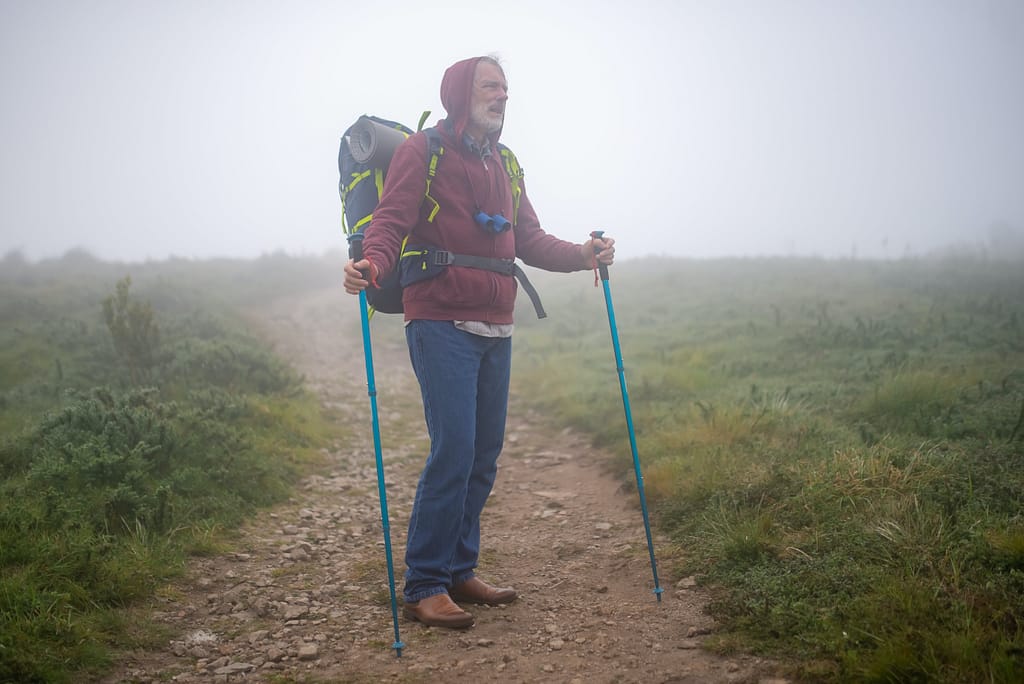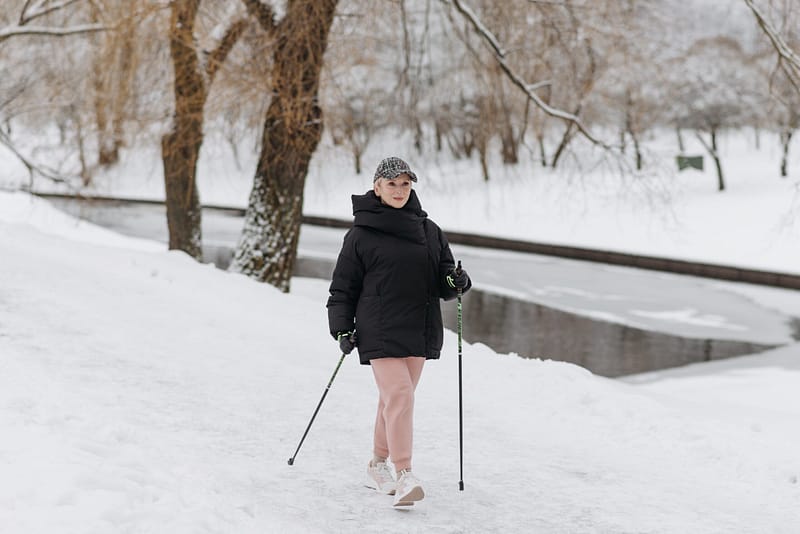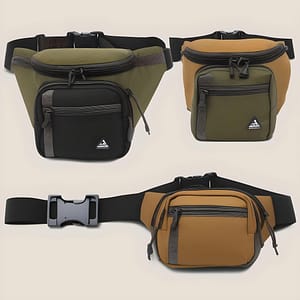Walking poles for seniors are a practical and effective solution to improve stability and mobility. With their added support and balance, seniors can confidently enjoy outdoor activities like camping and stay active for longer.
Benefits of walking poles for seniors
Walking poles provide crucial support that enhances balance and coordination, making steps more confident and secure. The design of the poles aids in distributing body weight more evenly, reducing strain on the knees, hips, and spine, thereby minimizing the risk of injuries or joint pain often associated with walking.
By engaging the upper body muscles, walking poles turn a simple stroll into a full-body workout, dubbed a “nordic walking” experience. This not only improves cardiovascular health but also increases calorie burn. Moreover, the rhythmic motion of planting poles can establish a steadier pace, making the process of walking both more efficacious and enjoyable, especially over uneven terrain where stability is key.
Enhancing Balance
For seniors strolling through nature, uneven terrain isn’t just an inconvenience—it’s a challenge to stability. Walking poles offer a reliable brace, literally putting balance back into the hands of the user. These aids serve as extensions of the body’s own mechanisms to maintain an upright and stable posture while in motion.
Coupling arm’s natural swing with walking poles creates a dynamic “four-legged” stability system. With each step, poles touch the ground ahead, providing pre-emptive support. The effect is immediate and practical; especially when traversing slopes or dealing with obstacles, it’s akin to having an extra set of limbs to lean on.
Walking poles can reduce fall risk for seniors by up to 47%.
Implementing walking poles into a senior’s hiking gear can significantly enhance their confidence. Not only does this stability tool reduce the risk of falls, it promotes a more upright posture, aiding in better breathing and reducing fatigue during treks. Thus, seniors can embrace the great outdoors with vigor, ensuring an ongoing affair with adventure and wellbeing.
Joint Stress Reduction
Walking poles act as a pressure release valve for your joints, easing the burden with each stride.
- Disperse impact to lower pressure on knee joints during descents
- Support body weight more evenly, curtailing stress on the hips and spine
- Enhance muscle engagement, alleviating direct stress on joints
- Provide rhythm and pace, which can lead to smoother movement and less jarring motions
Accommodating more than just stability, they’re a joint’s best friend on the trail.
Introducing walking poles lessens the jarring impact that walking can imprint on senior trekkers’ joints, promoting longevity in their outdoor pursuits.
Cardiovascular Health Boost
Striding along with walking poles gets the blood pumping more vigorously than a casual stroll. Engaging the upper body, in addition to the legs, walking poles transform a simple walk into a holistic cardiovascular workout that can significantly bolster heart health.
By activating larger muscle groups in both your upper and lower body, walking poles create a scenario where the heart must work a tad harder to supply the necessary nutrients and oxygen. This elevates your heart rate, improves circulation, and over time can lower blood pressure and reduce the risk of heart disease. Your cardiovascular system gets a comprehensive tune-up with each outing.
Moreover, this amplified exercise intensity doesn’t come with a hefty price of increased discomfort or risk. Walking poles distribute physical efforts across the body, allowing you to push your cardiovascular system without overtaxing your joints. So, you reap the cardio benefits while protecting your body from undue strain, which is especially vital as you age.
Beyond just health, the use of walking poles stimulates the release of mood-enhancing endorphins which are beneficial for emotional wellbeing. Regular pole walking sessions can lead to greater stamina, a more robust heart, and an elevated mood. Such a combination paves the way for a sustained commitment to cardiovascular health, enabling seniors to continue exploring and enjoying the outdoors with a strengthened heart and a smile on their face.
Choosing the Right walking poles for seniors
Selecting the ideal walking poles for seniors isn’t just about grabbing the first pair you see. It’s about finding the perfect match for your body and walking style. Look for poles with ergonomic grips that cater to your hands’ contours, ensuring comfort over long distances. The adjustability factor is crucial—telescopic poles fit your specific height and walking terrain. And don’t overlook the locking mechanism: it must be secure yet easy for your hands to operate. Lastly, consider the pole tips; you’ll need durable, versatile tips for various surfaces, whether you’re tackling smooth sidewalks or rugged trails.
Adjustable vs. Fixed-Length Poles
When choosing walking poles, seniors must weigh the merits of adjustable versus fixed-length models. Both have distinct advantages and particular considerations that may influence your decision.
Adjustable poles can be customized to your precise height, ensuring optimal comfort and support.
Fixed-length poles offer a consistent experience, with no adjustments needed once you find your perfect fit.
However, the mechanisms for adjusting can be tricky for some, potentially complicating what should be a straightforward aid to mobility.
Adjustable poles also allow for easier transport and storage, as they can collapse down to a manageable size.
If you plan to share your poles or use them across different activities, adjustable variants provide the flexibility to adjust for varying conditions and terrain.
Conversely, if you seek a simpler, more durable option, fixed-length poles may offer greater reliability without the fuss of moving parts.
Grip Types for Comfort
Ergonomic handles are the name of the game when it comes to walking pole grips.
For instance, cork grips wick away moisture, making them ideal for hot and humid conditions, while foam handles absorb vibrations, helping to lessen the impact on your joints. Rubber grips are durable and offer good resistance to wear and tear, but they may not be as comfortable in extreme temperatures. Each grip material comes with its pros and cons, so consider the climate and your personal preferences when choosing.
Picking the right grip also includes thinking about the shape of the handle. Traditional T-shaped handles can work, but many seniors prefer the ergonomic design of a pistol or cane-shaped grip. These shapes are crafted to follow the natural contour of your hand, reducing strain on your wrists and providing a more secure, comfortable experience.
Lastly, the strap of the walking pole is an element not to overlook. It should adjust to secure your wrist comfortably, preventing unnecessary strain as you navigate various terrains. Advanced designs may come with padded or lined straps, which further enhance comfort and make using walking poles for extended periods much easier, greatly reducing the chances of chaffing or skin irritation.
Pole Material Considerations
When it comes to the poles themselves, aluminum, carbon fiber, and composite materials take center stage, each offering distinct advantages tailored toward varying terrains and uses.
Aluminum poles are renowned for their robustness and cost-effectiveness, making them a smart choice for the budget-conscious trekker.
On the flip side, carbon fiber offers a reduction in weight, a boon for those looking to minimize their load without compromising pole strength.
Yet composites, a blend of carbon and aluminum, seek a middle ground, balancing weight and durability, often seen in higher-end models.
Consider this: as seniors, stability is crucial, but so is the ease of porting poles around. Hence, weight becomes a pivotal factor, ever more so when planning longer jaunts or hikes involving varied elevations.
Remember, the intent here is not to peddle the lightest nor the sturdiest alone but to find the material mix that best harmonizes with an individual’s needs and hiking style.

Proper Technique for Maximum Gain
Proper grip technique eases wrist strain and enhances pole use—fingers loosely looped through straps, thumbs overtop.
When planting poles, aim for a natural rhythm syncing arm swing and leg stride, maintaining a relaxed posture, which will optimize energy use and reduce fatigue over distance.
Avoid “slamming” poles down; instead, place them softly to ensure efficient support and terrain sensing.
Mastering the Pole Plant
Pole planting is more art than brute force.
To truly master the pole plant, start with understanding the mechanics. The pole should hit the ground as your opposite foot strikes forward, creating a balanced, alternating rhythm akin to a well-oiled machine. Similarly, the angle at which you plant your pole directly affects the support and propulsion you’ll receive, so it’s critical to get the angle just right. Aim for a slight forward tilt, which optimizes stability and leverage.
The diagonal line is your secret pole planting ally.
An effective pole plant requires precision – aim for the right spot every time. It’s about creating a stable pivot point with each step, using the pole to propel you forward efficiently, without wasted energy. Moreover, consistent planting technique enhances endurance, particularly during those longer and more challenging treks.
Perfecting this takes practice and patience.
Your poles are an extension of your body – use them intuitively. When embarking on uneven terrain, adjust your pole length and planting technique as needed to maintain balance and support. Like any skill worth acquiring, proficiency comes over time, with frequent use and attention to the subtle nuances of the terrain underfoot.
Pole planting can elevate your trek to graceful efficiency.
Walking Pole Arm Swing
Proper arm swing is crucial when using walking poles, creating a natural rhythm that enhances stability and conserves energy.
- Relax your shoulders and drop them slightly to foster a comfortable posture.
- Bend your elbows at a comfortable angle, usually around 90 degrees, and keep your wrists straight.
- Coordinate your arm swing with the opposite leg’s stride to maintain balance.
- Push down lightly on the pole grip with your hand as you swing the pole forward.
- Follow through with your arm swinging backward, preparing for the next pole plant.
- Adjust your grip as necessary for varying terrain, ensuring continuous control and comfort.Smooth pole use should mesh with your gait, never fighting against your movement.
Each phase of your arm swing plays a key role in propelling you forward, boosting efficiency while reducing strain on your joints.
Pole Length Adjustment Tips
Customize for your height: Your poles should reach your wrists when your arms are at your sides.
Adjust for uphill travels: Shorten poles to maintain proper posture and efficacy.
On the descent, lengthen your poles to aid in stability and take pressure off your knees, ensuring they hit the ground at a comfortable distance ahead of you.
Poles can be a true asset in diverse terrains; for a flat surface, set them at your ideal height. On an incline, don’t shy away from shortening them slightly for increased uphill leverage. Conversely, when you’re tackling a downward slope, let them grow a touch longer — your joints will thank you for that extra bit of support and control that keeps the adventure going strong. Always remember, a “just right” adjustment can optimize your trekking efficiency.
Integrating Poles into Daily Routines
Adopting walking poles into everyday life can be as seamless as lacing up your favorite pair of hiking boots. Start by incorporating them into your regular walks, whether that’s a morning stroll through the neighborhood or an afternoon hike on local trails. Their presence becomes an extension of your natural stride, providing stability and encouraging an enhanced posture that radiates confidence and control.
As you make poles a staple in your daily sojourns, their benefits multiply. Think of them as your “pavement partners” when navigating city streets or as “trail teammates” during those scenic park explorations. By consistently using them, they become not just an aid but a significant contributor to your overall fitness. Over time, the added propulsion and reduced impact on your joints help to make walking more of a full-body exercise, increasing endurance and muscle tone with each step you take.
Starting with Short Walks
For seniors, walking is more than just a leisurely activity. It’s a vital exercise that maintains mobility, balance, and overall health. To get started, pick an easy, familiar route. Make it a short loop that’s close to home, and take it at a comfortable pace.
Initiate this journey with walking poles in hand for added stability and support.
Progress incrementally, allowing your body to adapt to the new dynamics of walking with poles. Begin with 10 to 15 minutes of walking, then gradually increase the duration. The goal is to find a balance between challenging yourself and listening to your body’s signals.
Building consistency is key. Regular short walks with poles not only strengthen muscles but also improve coordination and balance. Over time, you’ll notice enhanced stability during your walks. Always prioritize safety over distance or speed, especially when adapting to poles. This approach offers a gentle yet effective pathway to increased fitness and well-being.
Poles on Different Terrains
Sand can be tricky underfoot.
When trodding on sandy soil, poles create a stable base to help distribute your weight more evenly. They act as anchors, preventing excessive sinking and providing leverage for an easier lift with each step. Moreover, using poles can reduce the strain on leg muscles by transferring some of the work to the upper body.
Gravel requires concentrated efforts.
Stepping onto gravel, let poles lead the way – they offer critical support and balance. The tips dig in, offering traction to negotiate pebbly paths securely. It’s all about creating a rhythmic dance between pole and foot for seamless movement.
Mud is less daunting with poles.
As you conquer muddy trails, poles transform into indispensable tools for stability. The soft ground may shift, but your poles remain a steadfast ally, allowing you to probe ahead for firmer footing.
When snow blankets the trail, poles become essential.
They add balance and support as you navigate the slippery terrain. Also, poles can help in judging snow depth and revealing hidden obstacles, contributing to safe passage. After all, the last thing you need is an unwelcome slip when the ground hides under a powdery white veil.
Increasing Difficulty Over Time
Mobility can decrease with each passing year.
As we age, it’s not just the number of candles on our birthday cake that’s on the rise. Our bodies can start to show signs of wear and tear, leading to a natural decrease in stability and mobility. This gradual shift can affect everything from our gait to our balance, often without us fully realizing it until we face a challenge that underscores the change.
Walking becomes a conscious effort.
Hiking trails that once felt like a walk in the park can start to seem like uncharted territory. It’s as if the paths have become steeper, the distances longer, and the terrain more treacherous with time.
Poles turn into trusted companions.
The trail’s incline feels steeper now – as if mountains have grown taller, emphasizing the challenge for weakening muscles. The stability offered by walking poles becomes not just helpful, but essential, creating a reliable partnership between person and tool.
Every step matters more as time goes on.
With the golden years come valuable experiences but also challenges that test our physical prowess. Poles become a way to tackle these head-on, offering a helping hand to navigate the increasingly difficult terrain that life – and nature – places before us.
In conclusion
Walking poles can be a valuable tool for seniors looking to improve their stability and mobility. These poles provide added support and balance, making it easier for seniors to enjoy outdoor activities such as camping. By using walking poles, seniors can reduce the risk of falls and injuries, allowing them to stay active and independent for longer. Whether it’s navigating uneven terrain or simply going for a leisurely walk, walking poles can make a significant difference in the lives of seniors. So, if you’re a senior looking to enhance your outdoor experience, don’t hesitate to give walking poles a try. They may just become your new favorite companion on your camping adventures.





